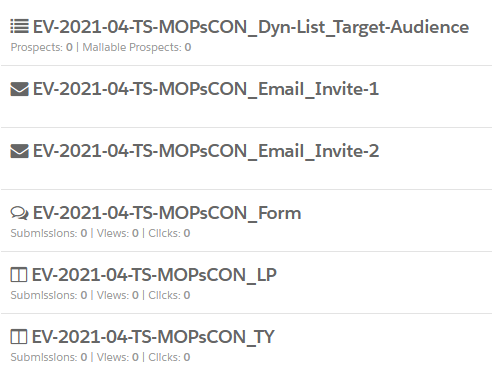Overview
Are you tired of sifting through a disorganized marketing automation platform, wasting precious time searching for assets and campaigns? Salesforce Marketing Cloud Account Engagement, formerly known as Pardot, can be a powerful ally in your marketing efforts, but only if you have a structured folder system and a consistent asset naming convention in place.
The Importance of Organization
Organizing your marketing automation platform is not just a matter of convenience; it’s a strategic move that can significantly impact your marketing team’s productivity. Without a well-structured folder system and clear asset naming conventions, you risk creating chaos within your Marketing Cloud Account Engagement environment. Here’s why organization matters:
Scalability
A clean, organized instance is the foundation for scalability. As your marketing efforts grow, so will the number of assets, campaigns, and data points you manage. Without a solid organizational structure, you’re likely to end up drowning in a sea of disarray.
Efficiency
Efficiency is key in marketing automation. With a well-organized Marketing Cloud Account Engagement instance, your marketing team can complete tasks quickly and efficiently. Time, energy, and money are valuable resources that you can save by implementing a robust folder structure and naming convention.
Folder Structure in Marketing Cloud Account Engagement
Understanding Marketing Cloud Account Engagement’s Folder Construct
Marketing Cloud Account Engagement introduced folders in 2014 to provide a structured way to segment and nest content. However, some limitations still exist. Here are a few key points to understand:
- Marketing Cloud Account Engagement limits each folder to a maximum of 10,000 items and allows a maximum of 16 subfolders.
- Folders are the basis for scoring categories and user permissions.
- Marketing Cloud Account Engagement relies on the ASCII table to order folders, allowing you to use special symbols for prioritization.
- First Level of Priority:
! ” # $ % & ‘ ( ) * + , – . - Second Level of Priority:
00 01 02 03 04 05 06 07 08 09 10 : ; < = > ? @ - Third Level of Priority:
A B C D… etc
a b c d… etc
- First Level of Priority:
Folder Recommendations
To create an efficient folder structure, we recommend a baseline hierarchy:
- Team: The highest-level folder based on your organizational structure.
- Category: Includes all use cases or team needs, such as Marketing Activities, Operational Process, Testing, and Training.
- Campaign Type: Reflects the marketing medium for campaign initiatives, aligned with the picklist values in the Campaign Type field in Salesforce.
- Initiative: The campaign folder.
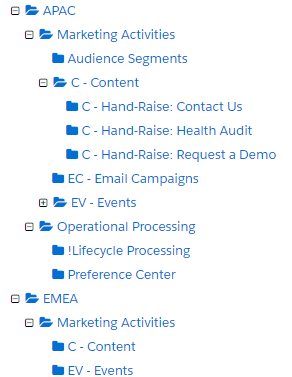
Depending on your organization’s needs, you can add more granularity by introducing folders like Region or Business Unit. The top-level folder should align closely with team structure and permissions, while campaign type subfolders help organize initiatives efficiently.
The structure you choose depends on your organization’s specific requirements.
Using Folders for Initiatives
Whether you stick to the baseline structure or expand it, using folders for individual marketing initiatives offers several benefits:
- Efficient Asset Grouping: Folders help group all components of an initiative in one location, making it easier to find associated assets.
- Enhanced Search: Since global search is limited in Marketing Cloud Account Engagement, using folders allows you to navigate through asset sections more efficiently.
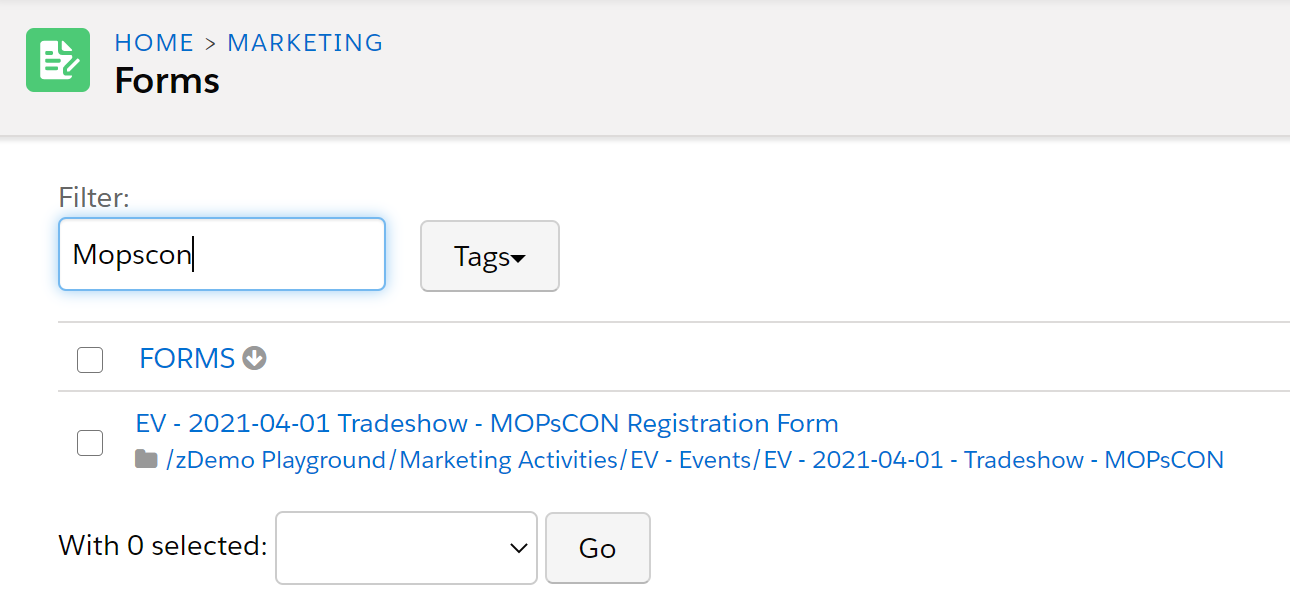
Using Folders for Scoring
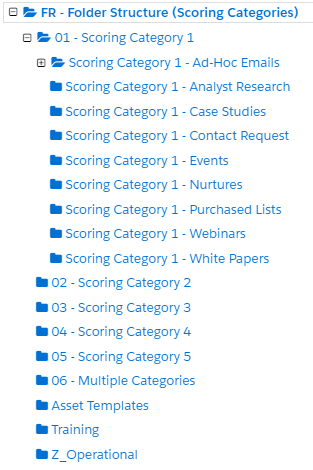
Marketing Cloud Account Engagement folders can also be valuable for product interest scoring. To implement this, ensure a well-defined folder structure is in place. Here’s how it works:
- Start with high-level folders assigned to each scoring category.
- Create sub-folders under each high-level folder, reflecting the same scoring category.
- This approach helps you align assets with specific products and scoring categories.
Naming Conventions
While a folder structure is essential, naming conventions add an extra layer of organization and clarity. Here’s how to create a strong naming convention for your Marketing Cloud Account Engagement assets:
Initiative Folders
Start with initiative folders and follow this baseline recommendation:
[Campaign Type]-YYYY-MM-[Campaign Type Subcategory]-[Short-Name]
The elements of the naming convention are as follows:
- Campaign Type Abbreviation: Consistent with the folders (e.g., EV for Event, C for Content).
- Dates: Use a four-digit year, followed by a two-digit month (and day if necessary).
- Campaign Type Subcategory: Specify the campaign type subcategory.
- Short Name: Provide a brief, hyphenated description of the initiative.
Not all initiatives require every component; adapt the convention as needed. If you use geographical or brand criteria, incorporate them into the naming convention.
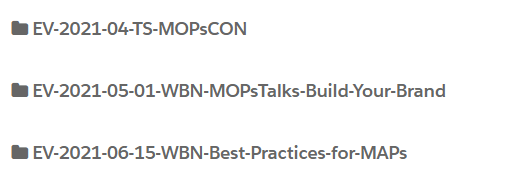
Asset Naming
Apply the naming convention consistently to all asset types. Here’s the structure:
[Initiative-Name][Asset-Type][Asset-Descriptor]
To avoid exceeding the 50-character limit, keep these guidelines in mind:
- Initiative names should not exceed 30 characters.
- Asset types should be concise, with a maximum of 15 characters.
- Use asset descriptors only when necessary.
- Separate components with underscores for clarity while using hyphens within each component.
Automation Naming
For automation rules, the convention is slightly different:
[Category Prefix]-[Function]-[Short Name]
Elements of the naming convention for automations include:
- Category Prefix: Differentiate operational rules from marketing rules (e.g., OPs for operational, MKTG for marketing).
- Function Prefix: Define the functional purpose of the rule (e.g., Lifecycle for lifecycle processing).
- Short Name: Offer a brief description of the automation action.
Implementing Your Conventions
Implementing naming conventions and ensuring adherence may seem daunting, but the benefits are well worth the effort. Once established, these conventions will streamline your team’s navigation within Marketing Cloud Account Engagement and enhance overall efficiency. A well-organized Marketing Cloud Account Engagement instance can be a game-changer for your marketing operations team!
Did your organization just purchase Marketing Cloud Account Engagement or do you just happen to be a new user? Check out our new user mini guide here!
We’re here to help! If you’d like to learn more about how Etumos helps Marketing Cloud Account Engagement clients optimize their platform usage, don’t hesitate to get in touch.
